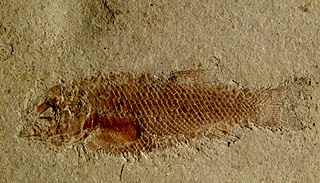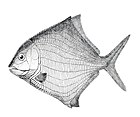Chichia is an extinct genus of prehistoric bony fish that lived during the Lopingian epoch in what is now Xinjiang, China.
Neuburgella is an extinct genus of prehistoric bony fish that lived during the Cisuralian epoch in what is now Kazakhstan.

Rhabdolepis is an extinct genus of prehistoric bony fish that lived during the Asselian age of the Cisuralian epoch in what is now Germany and France (Burgundy).
Inichthys is an extinct genus of prehistoric marine bony fish that lived during the Lopingian epoch. Fossils were recovered in the Kuznetsk Basin, European Russia.
Paralogoniscus is an extinct genus of prehistoric bony fish that lived during the Cisuralian epoch in what is now East Kazakhstan, Kazakhstan. It could reach body lengths of up to ca. 50 cm (20 in).
Tienshaniscus is an extinct genus of prehistoric bony fish that lived during the Lopingian epoch in what is now Xinjiang, China.
Trachelacanthus is an extinct genus of prehistoric bony fish that lived during the Late Permian epoch.
Watsonichthys is an extinct genus of prehistoric bony fish that lived during the Tournaisian age to possibly the Asselian age in what is now Europe and possibly Namibia. It is named after David Meredith Seares Watson.

Acentrophorus is an extinct genus of prehistoric ray-finned fish from the Wuchiapingian of England and Germany (Kupferschiefer). There may also be a Triassic occurrence in Australia.

Aeduella is an extinct genus of prehistoric freshwater bony fish that lived during the Gzhelian and Asselian-Sakmarian ages in what is now France, Germany, Switzerland and the Czech Republik.
Boreolepis is an extinct genus of prehistoric bony fish that lived during the Wuchiapingian age in what is now Clavering Island, Greenland, and Vologda Oblast, Russia.
Charleuxia is an extinct genus of prehistoric freshwater bony fish that lived during the Asselian age in what is now Burgundy, France (Autun).
Westollia is an extinct genus of prehistoric bony fish that lived during the Asselian age in what is now Thuringia, Germany.
Uydenia is an extinct genus of prehistoric bony fish from the Cisuralian of Kazakhstan.
Gardinerichthys is an extinct genus of freshwater actinopterygian bony fish from the Cisuralian epoch of Germany, and the middle Permian of India. The type species, G. latus, was discovered in Asselian aged layers (Rotliegend).
Eigilia is an extinct genus of prehistoric bony fish that lived during the Roadian age in what is now Kazakhstan.
Korutichthys is an extinct genus of prehistoric marine bony fish that lived during the Lopingian epoch in what is now Krasnoyarsk Krai, Russia. It was first referred to the family Amblypteridae, a view that was later questioned.
Gardinerpiscis is an extinct genus of prehistoric actinopterygian fish that lived during the Kungurian age of the early Permian epoch in what is now Kazakhstan. It was originally named "Gardineria" by Kazantseva-Selezneva (1981). Because this genus name was already given to an extant scleractinian coral, the new name Gardinerpiscis was erected for the Permian fish. The genus includes a single species (monotypy): Gardinerpiscis akkolkensis.
Turseodus is an extinct genus of ray-finned fish found in Late Triassic freshwater sediments of the United States. Two species have been described, T. acutus from the Lockatong Formation of Pennsylvania, and T. dolorensis from the Chinle Formation of Colorado.
Eigil Hans Aage Nielsen was a Danish paleontologist, who specialized in fossil vertebrate anatomy, particularly of Triassic bony fish.










